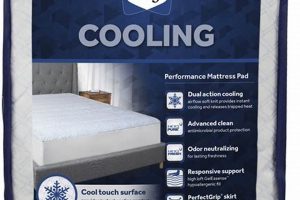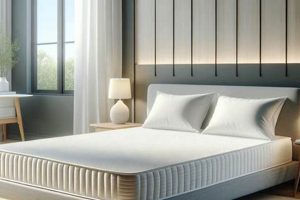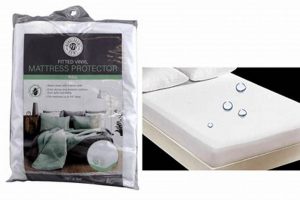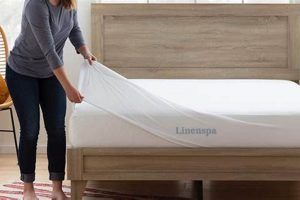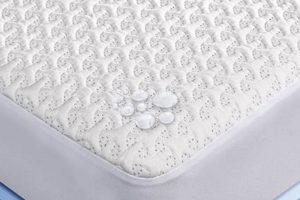This bedding accessory serves as a protective layer, extending the lifespan of a mattress. It is designed to shield against liquids, allergens, dust mites, and general wear and tear. Constructed from various materials, including waterproof or water-resistant fabrics, it encases the mattress, providing a barrier that helps maintain its cleanliness and integrity.
The implementation of a mattress safeguard offers several advantages. It contributes to a healthier sleep environment by minimizing allergens and dust mites, beneficial for individuals with sensitivities. Furthermore, it protects the investment in the mattress itself, preventing stains and damage that could void warranties. Historically, the use of such coverings has been prevalent to maintain hygiene and prolong the usability of mattresses, particularly in settings where cleanliness is paramount.
The subsequent sections will delve into the specific features, material composition, care instructions, and potential alternatives to consider when selecting a suitable mattress protection solution for optimal bed hygiene and longevity.
Guidance for Optimal Use
The following points provide essential advice to maximize the benefits and longevity of mattress protection.
Tip 1: Select the Appropriate Size: Ensure the protector matches the dimensions of the mattress precisely. An ill-fitting protector can compromise its effectiveness and durability.
Tip 2: Prioritize Breathable Materials: Opt for materials that allow for air circulation, minimizing heat retention and promoting a more comfortable sleep experience. Consider options like cotton or Tencel.
Tip 3: Adhere to Washing Instructions: Follow the manufacturer’s guidelines for cleaning. Regular washing, according to the instructions, is crucial for maintaining hygiene and preventing allergen build-up.
Tip 4: Address Spills Promptly: In the event of a spill, immediately blot the affected area to prevent penetration and staining. Delaying action can reduce the protector’s effectiveness.
Tip 5: Consider Waterproofing Needs: Assess the required level of waterproofing based on potential risks. Options range from water-resistant to fully waterproof, each offering varying degrees of protection.
Tip 6: Inspect Regularly for Wear and Tear: Periodically examine the protector for signs of damage, such as rips or tears. Addressing minor issues promptly can prevent them from escalating.
Tip 7: Utilize a Fitted Sheet: Always use a fitted sheet over the protector. This adds an additional layer of hygiene and protection, further extending the mattress’s lifespan.
Implementing these recommendations will contribute to a cleaner, healthier, and more protected sleep environment.
The final section will summarize the core findings and offer conclusive remarks regarding the selection and maintenance of mattress protection solutions.
1. Waterproof Barrier
The waterproof barrier constitutes a critical component in mattress protection. Its primary function is to prevent liquids, such as spills, sweat, or other forms of moisture, from penetrating the mattress core. Failure to prevent such ingress can lead to permanent staining, the growth of mold and mildew, and a compromised mattress structure. Therefore, the presence of a reliable waterproof barrier is paramount for maintaining the hygiene and longevity of the mattress.
The effectiveness of the waterproof barrier directly correlates with the materials and construction techniques employed. Polyurethane films or coatings are commonly used to achieve waterproofing, often laminated to a breathable fabric backing to mitigate heat retention. The barrier’s integrity must withstand regular use and washing cycles to ensure consistent protection. Instances of compromised or ineffective barriers often result in mattress damage, leading to costly replacements.
In summary, the waterproof barrier represents a core feature for protection, safeguarding it against liquid-related damage. Selecting a product with a robust, well-constructed waterproof layer is essential for preserving mattress quality, promoting a hygienic sleep environment, and preventing premature degradation. The practical implications of this feature extend to financial savings and improved sleep quality.
2. Hypoallergenic Fabric
The integration of hypoallergenic fabric into mattress protection serves as a critical element in creating a sleep environment conducive to respiratory health and overall well-being. It addresses a significant concern for individuals susceptible to allergies and sensitivities triggered by common household allergens.
- Minimizing Allergen Accumulation
Hypoallergenic fabrics, typically tightly woven or composed of synthetic materials, reduce the accumulation of dust mites, pet dander, and pollen within the bedding. These allergens, when present, can exacerbate allergic reactions, leading to respiratory distress and disrupted sleep patterns. Real-world examples include individuals with asthma experiencing fewer nocturnal symptoms and allergy sufferers reporting reduced nasal congestion.
- Material Composition and Construction
The selection of specific materials plays a pivotal role in achieving hypoallergenic properties. Microfiber fabrics, known for their dense weave, and materials treated with antimicrobial agents are frequently utilized. The construction method, such as tightly knit seams, further restricts allergen penetration. A comparative analysis reveals that protectors constructed with such fabrics exhibit superior allergen-blocking capabilities when contrasted with standard cotton or synthetic blends.
- Impact on Respiratory Health
The employment of hypoallergenic fabrics directly impacts respiratory health by mitigating exposure to airborne allergens. This is particularly relevant for individuals with pre-existing respiratory conditions, such as allergies, asthma, or chronic obstructive pulmonary disease (COPD). The implementation of such a barrier can lead to a measurable reduction in respiratory symptoms and an improvement in sleep quality, evidenced by clinical studies on indoor allergen reduction.
- Maintenance and Longevity
The effectiveness of hypoallergenic fabric depends on consistent maintenance. Regular washing, following the manufacturer’s instructions, is essential to remove accumulated allergens and maintain the fabric’s integrity. Failure to adhere to proper washing protocols can compromise the fabric’s hypoallergenic properties, leading to a resurgence of allergen-related symptoms. Longevity is influenced by the quality of materials used and the frequency of cleaning cycles.
In summation, the inclusion of hypoallergenic fabric represents a significant advancement in mattress protection, offering tangible benefits for individuals with allergies or respiratory sensitivities. Its effectiveness hinges on material composition, construction, consistent maintenance, and a comprehensive approach to managing indoor allergens.
3. Breathable Material
The selection of breathable materials in mattress protection is not merely a comfort consideration but a fundamental design attribute affecting hygiene, temperature regulation, and the overall lifespan of the mattress itself. Breathability, in this context, refers to the material’s capacity to permit air circulation, allowing moisture vapor to escape rather than accumulate within the mattress.
- Temperature Regulation
Breathable materials facilitate the dissipation of body heat, preventing the build-up of excessive warmth during sleep. Materials such as cotton, Tencel, and specialized synthetic blends promote airflow, creating a more comfortable sleep environment. Overheating can disrupt sleep cycles and contribute to discomfort, making temperature regulation a critical benefit. For example, individuals residing in warmer climates often find increased comfort with protectors made from breathable fabrics.
- Moisture Management
The ability of a material to wick away moisture is crucial for preventing the proliferation of mold, mildew, and bacteria within the mattress. Perspiration, humidity, and accidental spills can lead to moisture accumulation if the protector lacks sufficient breathability. Breathable fabrics allow moisture vapor to escape, maintaining a drier and more hygienic sleep surface. This is particularly relevant in humid environments or for individuals who experience night sweats.
- Material Composition and Construction
The specific composition and construction of the material directly influence its breathability. Tightly woven, non-porous materials restrict airflow, while more loosely woven or knit fabrics offer enhanced breathability. Microfiber fabrics, despite their tight weave, can be engineered with moisture-wicking properties to improve airflow. The choice of lamination techniques and waterproof membranes also affects overall breathability. Materials that incorporate natural fibers, like bamboo, often exhibit inherent breathability characteristics.
- Impact on Mattress Longevity
By preventing moisture accumulation, breathable mattress protection extends the lifespan of the underlying mattress. The presence of moisture creates a breeding ground for mold and mildew, which can degrade the mattress core and compromise its structural integrity. Breathable materials mitigate this risk, preserving the mattress’s condition and preventing premature replacement. This contributes to long-term cost savings and a more sustainable approach to bedding maintenance.
The integration of breathable materials into mattress protection directly addresses critical aspects of sleep comfort, hygiene, and mattress longevity. The selection of appropriate materials and construction techniques is paramount for maximizing the benefits of breathability, creating a more comfortable and sustainable sleep environment.
4. Fitted Design
The “fitted design” is an integral characteristic of the mattress protector, directly impacting its efficacy and the overall user experience. The design dictates how securely the protector affixes to the mattress, influencing its ability to perform its primary functions: protecting against spills, allergens, and wear. A properly fitted design ensures the protector remains taut and smooth, preventing slippage or bunching that could compromise its protective capabilities and reduce sleep comfort. Conversely, a poorly fitted design may expose areas of the mattress to potential damage, negating the benefits of using a protector.
The practical significance of a fitted design is readily observable in real-world scenarios. For instance, a protector that utilizes elasticized edges and deep pockets can accommodate mattresses of varying thicknesses, ensuring a snug and secure fit. This prevents the protector from shifting during sleep, thereby maintaining continuous coverage and protection. In contrast, a protector with a loose or inadequate fitting mechanism is prone to movement, creating gaps that allow liquids or allergens to penetrate. Furthermore, the fitted design contributes to the aesthetic appeal of the bed, presenting a clean and uniform appearance, which is particularly relevant in hospitality settings or for individuals prioritizing bedroom aesthetics. The design also simplifies the process of putting on and removing the protector, facilitating regular cleaning and maintenance.
In conclusion, the fitted design is not merely a superficial attribute but a critical factor in determining the functional effectiveness and user satisfaction with the mattress protector. Its ability to provide a secure and reliable fit directly correlates with the protector’s ability to safeguard the mattress, maintain a hygienic sleep environment, and enhance overall sleep comfort. Understanding the importance of fitted design is crucial for selecting a product that delivers optimal performance and value, thereby maximizing the investment in mattress protection.
5. Washable Feature
The washable feature is a fundamental attribute directly influencing the functionality and hygiene of a mattress protector. Its presence allows for the regular removal of accumulated allergens, dust mites, and bodily fluids, preventing the build-up of unsanitary conditions within the bedding. The washable design is not merely a convenience but an essential element in maintaining a healthy sleep environment, contributing directly to both the longevity of the mattress and the well-being of the user. Without the ability to launder the protector, contaminants would accumulate, potentially leading to allergic reactions, respiratory issues, and the degradation of the mattress’s structural integrity. The effectiveness of the mattress protector relies on its regular cleaning cycle and its ability to withstand multiple washes without compromising its protective qualities.
The practical significance of a washable mattress protector is evident in various scenarios. Consider the case of a household with young children or pets, where accidental spills and messes are frequent occurrences. A washable protector allows for immediate and thorough cleaning, preventing stains and odors from permeating the mattress. Similarly, individuals prone to night sweats or those living in humid climates benefit significantly from the ability to regularly wash their mattress protection, reducing the risk of mold and mildew growth. The frequency of washing should align with the manufacturer’s instructions, typically every one to two months, or more frequently in cases of spills or heavy soiling. The material composition of the protector must withstand these repeated washing cycles without shrinking, tearing, or losing its waterproof or hypoallergenic properties. Protectors made from durable, machine-washable materials are therefore preferable.
In conclusion, the washable feature is a non-negotiable aspect of effective mattress protection. Its presence guarantees the maintenance of a clean and hygienic sleep surface, mitigates the risk of allergen accumulation, and extends the lifespan of the mattress. The selection of a protector with a durable, washable design, coupled with adherence to proper cleaning protocols, represents a critical investment in both the health and longevity of the bedding. The absence of this feature significantly diminishes the protector’s value and jeopardizes the overall hygiene of the sleep environment. The connection between the mattress protector and washable feature will contribute a better sleep.
6. Durability, Quality
The longevity and protective efficacy of a mattress protector are inextricably linked to its durability and overall quality. These factors determine the product’s ability to withstand regular use, repeated washing, and the inevitable stresses of daily life. A compromise in either durability or quality directly diminishes the protector’s capacity to safeguard the mattress from stains, allergens, and physical damage, ultimately shortening the mattress’s lifespan and potentially compromising hygiene. The interplay between these attributes represents a critical consideration for informed purchasing decisions. The “lucid mattress protector” product is created with these component.
Materials and construction techniques exert a profound influence on a protector’s durability and quality. Protectors constructed from tightly woven, high-thread-count fabrics exhibit superior resistance to tearing, abrasion, and penetration by liquids. Reinforced seams and robust elasticized edges contribute to structural integrity, preventing premature wear and tear. Waterproof membranes, if present, must be constructed from durable, non-toxic materials capable of withstanding repeated washing cycles without delamination or loss of effectiveness. For example, protectors utilizing thin, low-quality waterproof layers often crack or degrade after only a few washes, rendering them ineffective. The lucid mattress protector ensures high product control and components.
In summary, durability and quality represent paramount considerations in the selection of a mattress protector. These attributes dictate the product’s ability to provide consistent, long-term protection and contribute to a healthier sleep environment. Prioritizing durability and quality translates to a more sustainable and cost-effective investment, minimizing the need for frequent replacements and ensuring the continued protection of the underlying mattress and in addition,lucid mattress protector emphasizes this product component.
7. Dust Mite Protection
Dust mite protection constitutes a critical function of mattress protectors, directly impacting the hygiene and healthfulness of the sleep environment. Given that mattresses provide an ideal habitat for dust mites, effective mitigation strategies are essential. Mattress protectors, including the “lucid mattress protector,” often incorporate specific design features and materials to minimize dust mite colonization.
- Barrier Properties
The primary mechanism for dust mite protection involves creating a physical barrier. Tightly woven fabrics, often used in the construction of “lucid mattress protector,” prevent dust mites from penetrating the mattress core. This barrier restricts access to the mites’ food source (shed skin cells) and inhibits their ability to thrive. For example, a laboratory test might demonstrate a significant reduction in dust mite counts on mattresses covered with such protectors compared to unprotected mattresses.
- Hypoallergenic Materials
Certain materials exhibit inherent hypoallergenic properties, further reducing dust mite populations. Synthetic fabrics, such as polyester or microfiber, are less conducive to dust mite proliferation than natural fibers like cotton. “lucid mattress protector” models employing these materials contribute to a less hospitable environment for dust mites. This reduced mite population translates to fewer allergens in the sleep environment.
- Washability
Regular laundering of mattress protectors is crucial for maintaining dust mite control. Hot water washing (at least 130F or 54.4C) effectively kills dust mites and removes their allergenic waste products. The “lucid mattress protector,” when designed for machine washing, allows for convenient and effective dust mite removal. Failure to regularly wash the protector undermines its protective capabilities.
- Encapsulation
Some mattress protectors feature full encasement designs, completely sealing the mattress. This approach provides a comprehensive barrier against dust mites, preventing both colonization and allergen escape. While not all “lucid mattress protector” models may offer full encasement, those that do provide enhanced dust mite protection, particularly for individuals with severe allergies.
These facets highlight the multi-faceted approach to dust mite protection offered by mattress protectors. The effectiveness of “lucid mattress protector” in this regard depends on its specific design, materials, and the adherence to proper maintenance protocols. A well-chosen and properly maintained protector significantly reduces dust mite populations, contributing to a healthier and more comfortable sleep environment.
Frequently Asked Questions
This section addresses common inquiries concerning mattress protectors, providing clear and concise information to aid in informed decision-making.
Question 1: What is the intended purpose of a lucid mattress protector?
The primary function is to safeguard the mattress from liquids, allergens, dust mites, and general wear. It serves as a barrier, prolonging the mattress’s lifespan and maintaining a hygienic sleep environment.
Question 2: How often should a lucid mattress protector be washed?
Washing frequency depends on usage and environmental factors. Generally, laundering every one to two months is recommended, or more frequently in the event of spills or heavy soiling. Adherence to the manufacturer’s instructions is crucial.
Question 3: Are all lucid mattress protectors waterproof?
Not all protectors offer complete waterproofing. Some provide water resistance, while others are fully waterproof. The level of protection depends on the materials used and the construction techniques employed. Product specifications should be carefully reviewed prior to purchase.
Question 4: Can a lucid mattress protector be used on memory foam mattresses?
Yes, protectors are compatible with memory foam mattresses. Selecting a breathable protector is recommended to minimize heat retention associated with memory foam.
Question 5: Will a lucid mattress protector alter the feel of the mattress?
The impact on mattress feel varies depending on the protector’s thickness and materials. Thinner protectors typically have minimal impact, while thicker, padded options may slightly alter the mattress’s firmness.
Question 6: How does a lucid mattress protector protect against dust mites?
Protectors act as a barrier, preventing dust mites from penetrating the mattress core. Tightly woven fabrics and hypoallergenic materials further minimize dust mite colonization. Regular washing removes accumulated dust mites and allergens.
These frequently asked questions provide a foundation for understanding the purpose, maintenance, and benefits of mattress protectors. Further research and consultation with product specifications are encouraged for specific product inquiries.
The following section will address the advantages and disadvantages associated with using a mattress protector.
Conclusion
This exploration of “lucid mattress protector” has elucidated its critical role in safeguarding mattresses and fostering healthier sleep environments. The product’s functionality extends beyond mere surface protection, encompassing benefits such as allergen mitigation, dust mite control, and prolonged mattress lifespan. The selection of a suitable “lucid mattress protector” necessitates careful consideration of material composition, design features, and individual needs.
The utilization of a mattress protector represents a proactive investment in both bedding hygiene and personal well-being. As research and development continue to yield advancements in material science and design, the efficacy and convenience of mattress protection are poised to further improve. The continued prioritization of mattress protection aligns with a broader commitment to promoting restful and restorative sleep, a cornerstone of overall health and vitality.


